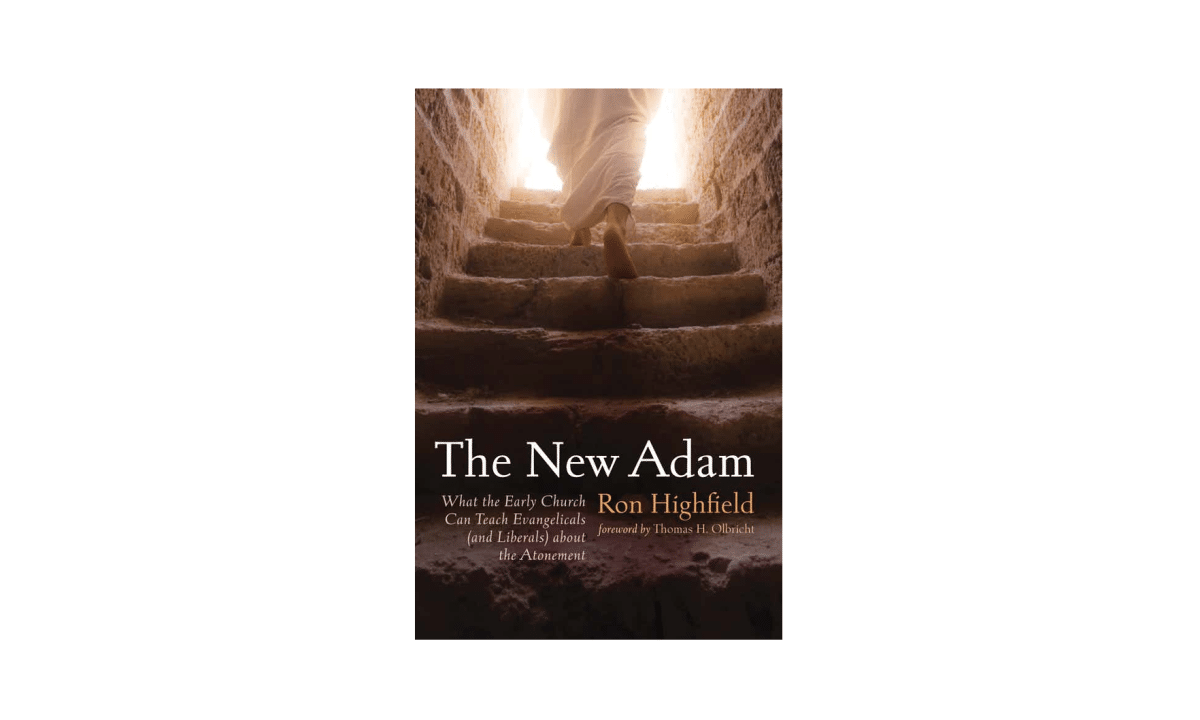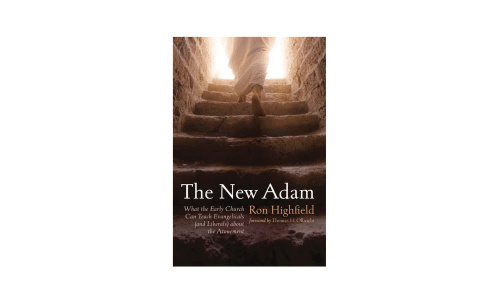

THE NEW ADAM: What the Early Church Can Teach Evangelicals (and Liberals) about the Atonement. By Ron Highfield. Foreword by Thomas H. Olbricht. Eugene, OR: Cascade Books, 2021. Xxi + 218 pages.
Paul told the Corinthians he held to be of first importance that “Christ died for our sins in accordance with the scriptures, and that he was buried, and that he was raised on the third day in accordance with the Scriptures” (1 Cor. 15:3-4). He also mentions the witnesses to this reality, beginning with Cephas (Peter), confirming the truth of his message. Thus, the death and resurrection are important to the Christian message, but how should understand these events, especially Jesus’ death on the cross. How did his death impact our sins? The answer to that question serves as a foundation for Paul’s message of salvation, but how? The doctrinal category under which this discussion falls is atonement. History shows that there’s more than one interpretation of atonement theory, so which one is correct? What does that mean for us?

Robert D. Cornwall
Many books have been written about the atonement, often arguing for a particular theory. In The New Adam, theologian Ron Highfield addresses to question of which theory might work best by taking us back to the early church to see what early Christians had to say about such things. Perhaps these Christians have better answers than the ones we’ve been embracing in modern times. Before we get to the heart of the book, I need to introduce the author. Highfield is a Professor of Religion at Pepperdine University. Like the university he serves, he is Church of Christ, which is a branch of the Stone Campbell Movement, a movement of which my denomination—Christian Church (Disciples of Christ) is also a branch. Church of Christ folks put a lot of emphasis on the New Testament and early Christian thought, so he’s well equipped to lead us in this conversation.
I’m going to preface the review by jumping to the end of the book, where Highfield points out that atonement theories rarely if ever prove effective as a means of witnessing to the Christian faith. When it comes to connecting the cross to forgiveness, “these theories presented in detail they receive them at best as curiosities that do little to increase their awareness of divine forgiveness.” It might be useful for some to know these theories, but ultimately, he suggests that when we share faith, keep it simple and tell the story of Jesus (pp. 188-190).
With this warning that detailed explanations of the atonement won’t get us very far in witnessing to the Christian faith— neither will making a big deal about how wretched we are (people really aren’t interested in knowing that they are horrible sinners who deserve to go to hell)—the Pepperdine University theologian offers us a take on the atonement question. With this caveat, Highfield reminds us that we seem to know that there are parts of our lives that can use some divine forgiveness, however that takes place. That is good news, even if the theories are rarely helpful.
If they are not an effective evangelistic tool, what do we do with these atonement theories? Do we need to bother defining them? The answer is yes, at least for those who are tasked with answering questions about how Jesus’ death influences our lives. With that in mind, Highfield divides the book into three parts. The first section describes the human condition. He suggests that we humans experience both greatness and wretchedness (in other words we’re not totally depraved). He looks at the question of our situation in life by engaging in conversation with Augustine, Blaise Pascal, and Soren Kierkegaard. You might call this a basic overview of our situation in life.
Part Two explores the same territory, only Highfield uses biblical categories. One chapter is titled “Destined for Glory: The Biblical View of Human Greatness.” In other words, Highfield speaks to our original situation. Then in chapter four, titled “Into a Distant Country” he explores the biblical view of human wretchedness.” In other words, how does sin affect who we are, considering that God created humanity as good? I should note that in all of this, Highfield embraces Irenaeus’ doctrine of recapitulation, a doctrine I have long found attractive.
Having laid out the human condition, noting that we’re not totally depraved. We’re marred by sin, but not totally. There is still good in us. This leads us to the main part of the book, Part Three, which focuses on Christian Soteriology. Interestingly, Highfield begins with the resurrection before he moves to the death of Jesus. This move is important because atonement theory focuses on the cross, not the resurrection, and yet Highfield turns the conversation on its head. While Jesus’ death comes first, the meaning of that death is defined by the resurrection. So, only after exploring the resurrection, does Highfield turn to Jesus’ death. He notes that it was early in Christian history that the cross became the central symbol of the faith. This is especially true in Western Christianity. This is a problem, as we’ll see.
Since Penal Substitution Theory is highly popular in western Protestant communities, Highfield devotes chapters seven and eight to forms of penal substitution. He starts with the classic Protestant theory as developed by the Reformers and that leans on Anselm. Before he gets to PSA, he briefly outlines seven basic atonement theories starting with the ransom theory. While all were available to the Reformers, penal substitution became the go-to theory for Protestants. With that in mind, in chapter seven, he looks at a variety of interpreters from the Reformers to post-reformation theologians such as Francis Turretin. Then he looks at Jonathan Edwards and Charles Hodge. Having introduced the traditional position in chapter seven, in chapter eight he speaks to contemporary evangelical theorists, including J. I. Packer, Wayne Grudem, and Millard Erickson. These two chapters give us a detailed picture of this classic and popular description of the cross. There are, however, significant problems with this idea. In part, it has to do with the question of whether the punishment fits the crime. Beyond this question is the question of whether this theory offers a rather negative view of God, who, according to the theory, demands the death of the Son in payment of a debt. It’s a simple theory, but it also offers a rather negative view of God. Part of the problem is the belief that we should be given our due. In other words, sin is an offense against God, it deserves the death penalty, and someone’s got to pay. So why not Jesus? The problem is that, according to Highfield, this theory divides justice from love in Christ.
If the evangelical solution, penal substitution, is problematic, the same is true of the liberal embrace of “Jesus as Example and Inspiration” (ch. 9). Although Peter Abelard is the classic proponent of moral influence theory, Highfield brings liberal theologians from Friedrich Schleiermacher to Marcus Borg into the conversation. Highfield’s concern concerns the nature of liberal Christology. He understands why liberals have let go of traditional Christologies, but he finds that this turn doesn’t resolve the problem of our relationship with God. In essence, what happens here is that divine action in the world is largely ruled out and for Highfield, that’s a nonstarter. He asks the question of why liberalism is “so hesitant to make assertion is about real, effective divine action in the world?” The answer is found in liberalism’s desire to “insulate itself from rational critique of divine causal actions.” So, as he reads liberal theologians, who seem to desire to avoid being marginalized, have chosen moral influence over divine action (p. 144). Yet, the question remains, where is God in all this? This has been my question as well.
If PSA and Moral Influence are found wanting, where might we turn? Highfield believes that the answer lies in early Christian thought, beginning with Irenaeus. If we start Irenaeus’ doctrine of recapitulation, then Jesus becomes the source of a new beginning. The goal is theosis through recapitulation. For Irenaeus, Jesus saves/reconciles us by going through every stage of human existence from birth to death (in this case death on a cross). In other words, Jesus’s life undoes Adam’s mistakes. As Jesus does this, he opens the way for theosis (deification), which ultimately involves union with God in Christ. Regarding theosis, Highfield notes that it involves participating in the divine nature. While he starts with Irenaeus, he works forward in time, bringing such figures as Clement of Alexandria, Athanasius, the Cappadocians, Maximus the Confessor, and others into the conversation. As you’ll note, these are all eastern theologians. The solution, it would seem, is to look east. With that in mind, we can embrace the goal of our destiny leading to participation in the divine nature (that is the divine energies and not divine essence, which is transcendent and unknowable). The good news that can be offered to the world is that we can experience oneness with God in this life. At least that’s the goal.
With this alternative to the two reigning Protestant visions of atonement in mind, Highfield speaks briefly about how we preach Christ. This is the reason for the book. He wants to provide us with a way of understanding theology that can “assist the church in helping people living today understand the message of salvation through Jesus Christ in a way that is true to the original gospel, resonates with their experience, and strikes them as good news?” So, what is the message? Well, it involves the human condition—we’re both great and wretched. It also involves a message of salvation in Christ. So, as we make this message known, don’t start with telling them they’re horrible sinners. People might admit to being sinners, but few if any believe they hate God. The basic message of penal substitution is simple but misleading. The key here is to keep the message simple, so rather than emphasizing atonement, let people know that God loves them and in doing so tell the story of Jesus. In other words, let people know that “in Jesus, our humanity has been united to God, glorified, and made immortal” (pp. 189-190).
This all seems like good news that might be well received by people seeking a sense of forgiveness for areas of concern in their lives as well as new beginnings that lead to wholeness in their lives. That’s a lot more attractive than hearing about sinners in the hands of an angry God who is willing to sacrifice the son, sort of like kicking the dog instead of beating the kid. When it comes to the heart of the book, my attraction to both recapitulation and theosis makes Highfield’s reading of the alternatives to the reigning Protestant theories very helpful. While this is a scholarly book, it’s accessible to a theologically sophisticated lay audience. It should prove very helpful to clergy who seek ways of making the good news of Jesus worth hearing. Yes, preachers will benefit from pondering the possibilities laid out here in Highfield’s The New Adam. That might also prove to be good news for congregations.
This review originally appeared on BobCornwall.com.
Robert D. Cornwall is an ordained minister in the Christian Church (Disciples of Christ). Now retired from his ministry at Central Woodward Christian Church (Disciples of Christ) of Troy, Michigan, he serves as Minister-at-Large in Troy. He holds a Ph.D. in Historical Theology from Fuller Theological Seminary and is the author of numerous books including his latest books: Called to Bless: Finding Hope by Reclaiming Our Spiritual Roots (Cascade Books, 2021) and Unfettered Spirit: Spiritual Gifts for the New Great Awakening, 2nd Edition, (Energion Publications, 2021). His blog Ponderings on a Faith Journey can be found at www.bobcornwall.com.






